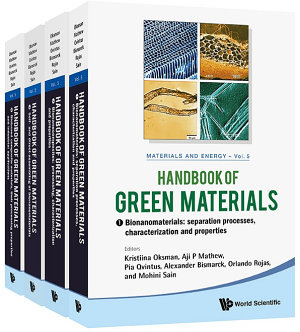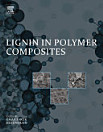Handbook Of Green Materials: Processing Technologies, Properties And Applications (In 4 Volumes)
Kristiina Oksman · Aji P Mathew · Alexander Bismarck · Orlando Rojas · Mohini Sain
Apr 2014 · Materials And Energy Book 5 · World Scientific
3.0star
1 reviewreport
Ebook
1124
Pages
family_home
Eligible
info
reportRatings and reviews aren’t verified Learn More
About this ebook
Green materials and green nanotechnology have gained widespread interest over the last 15 years; first in academia, then in related industries in the last few years.The Handbook of Green Materials serves as reference literature for undergraduates and graduates studying materials science and engineering, composite materials, chemical engineering, bioengineering and materials physics; and for researchers, professional engineers and consultants from polymer or forest industries who encounter biobased nanomaterials, bionanocomposites, self- and direct-assembled nanostructures and green composite materials in their lines of work.This four-volume set contains material ranging from basic, background information on the fields discussed, to reports on the latest research and industrial activities, and finally the works by contributing authors who are prominent experts of the subjects they address in this set.The four volumes comprise of:The first volume explains the structure of cellulose; different sources of raw material; the isolation/separation processes of nanomaterials from different material sources; and properties and characteristics of cellulose nanofibers and nanocrystals (starch nanomaterials). Information on the different characterization methods and the most important properties of biobased nanomaterials are also covered. The industrial point of view regarding both the processability and access of these nanomaterials, as well as large scale manufacturing and their industrial application is discussed — particularly in relation to the case of the paper industry.The second volume expounds on different bionanocomposites based on cellulose nanofibers or nanocrystals and their preparation/manufacturing processes. It also provides information on different characterization methods and the most important properties of bionanocomposites, as well as techniques of modeling the mechanical properties of nanocomposites. This volume presents the industrial point of view regarding large scale manufacturing and their applications from the perspective of their medical uses in printed electronics and in adhesives.The third volume deals with the ability of bionanomaterials to self-assemble in either liquids or forming organized solid materials. The chemistry of cellulose nanomaterials and chemical modifications as well as different assembling techniques and used characterization methods, and the most important properties which can be achieved by self-assembly, are described. The chapters, for example, discuss subjects such as ultra-light biobased aerogels based on cellulose and chitin, thin films suitable as barrier layers, self-sensing nanomaterials, and membranes for water purification.The fourth volume reviews green composite materials — including green raw materials — such as biobased carbon fibers, regenerated cellulose fibers and thermoplastic and thermoset polymers (e.g. PLA, bio-based polyolefines, polysaccharide polymers, natural rubber, bio-based polyurethane, lignin polymer, and furfurylalchohol). The most important composite processing technologies are described, including: prepregs of green composites, compounding, liquid composite molding, foaming, and compression molding. Industrial applications, especially for green transportation and the electronics industry, are also described.This four-volume set is a must-have for anyone keen to acquire knowledge on novel bionanomaterials — including structure-property correlations, isolation and purification processes of nanofibers and nanocrystals, their important characteristics, processing technologies, industrial up-scaling and suitable industry applications. The handbook is a useful reference not only for teaching activities but also for researchers who are working in this field.
Ratings and reviews
3.0
1 review
Rate this ebook
Tell us what you think.
Reading information
Smartphones and tablets
Install the Google Play Books app for Android and iPad/iPhone. It syncs automatically with your account and allows you to read online or offline wherever you are.
Laptops and computers
You can listen to audiobooks purchased on Google Play using your computer's web browser.
eReaders and other devices
To read on e-ink devices like Kobo eReaders, you'll need to download a file and transfer it to your device. Follow the detailed Help Center instructions to transfer the files to supported eReaders.








